Start Creating Documents, Databases, and More in Notion
Learn how to use Notion with our beginner's guide! Discover how to create pages, databases and more, and explore key use cases for this versatile app.
March 29, 2023
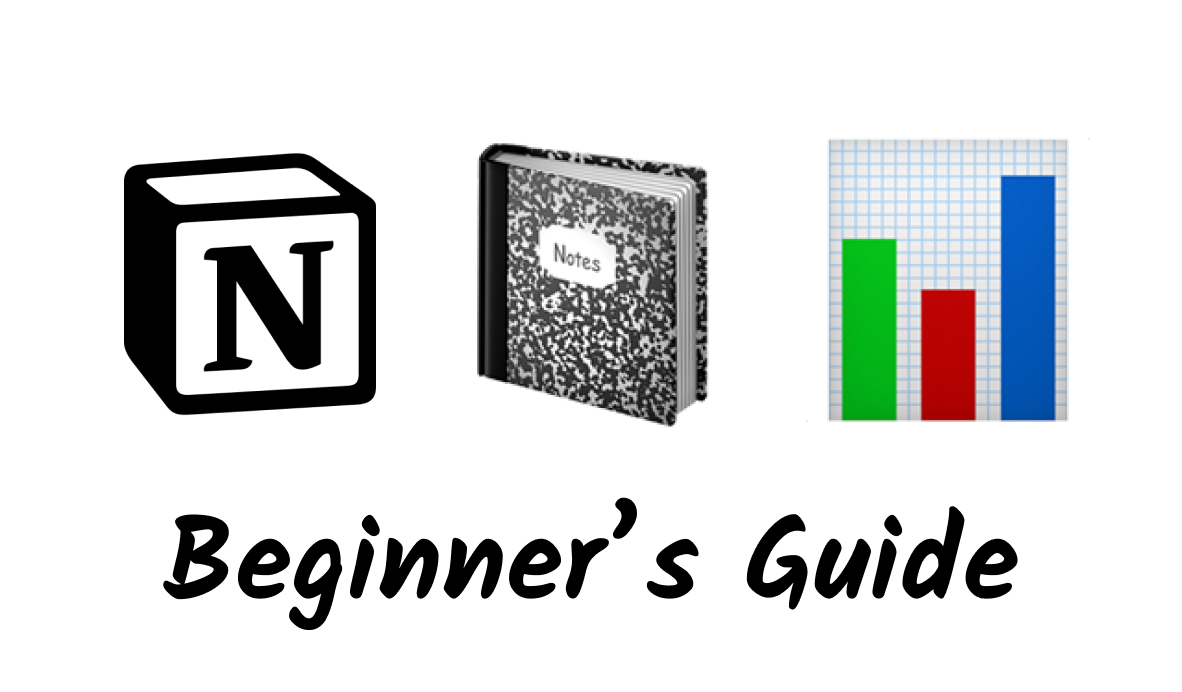
Are you still creating all of your docs in Google drive, word, or text edit? Still managing your to-dos in a clunky app like Monday? Whether you’re managing documents for your entire company, or just keeping track of personal tasks and information, there's a better way.
In this guide, we’ll show you the basics of Notion, one of the best apps for docs and notes available right now.
We’ll highlight the key features of Notion, and walk you through creating pages, databases, and more so you can start building your own Notion docs.
What is Notion?
First, let’s cover the basics. What is Notion?
According to their own website, Notion is a tool that lets you put your wiki, docs, and projects together.
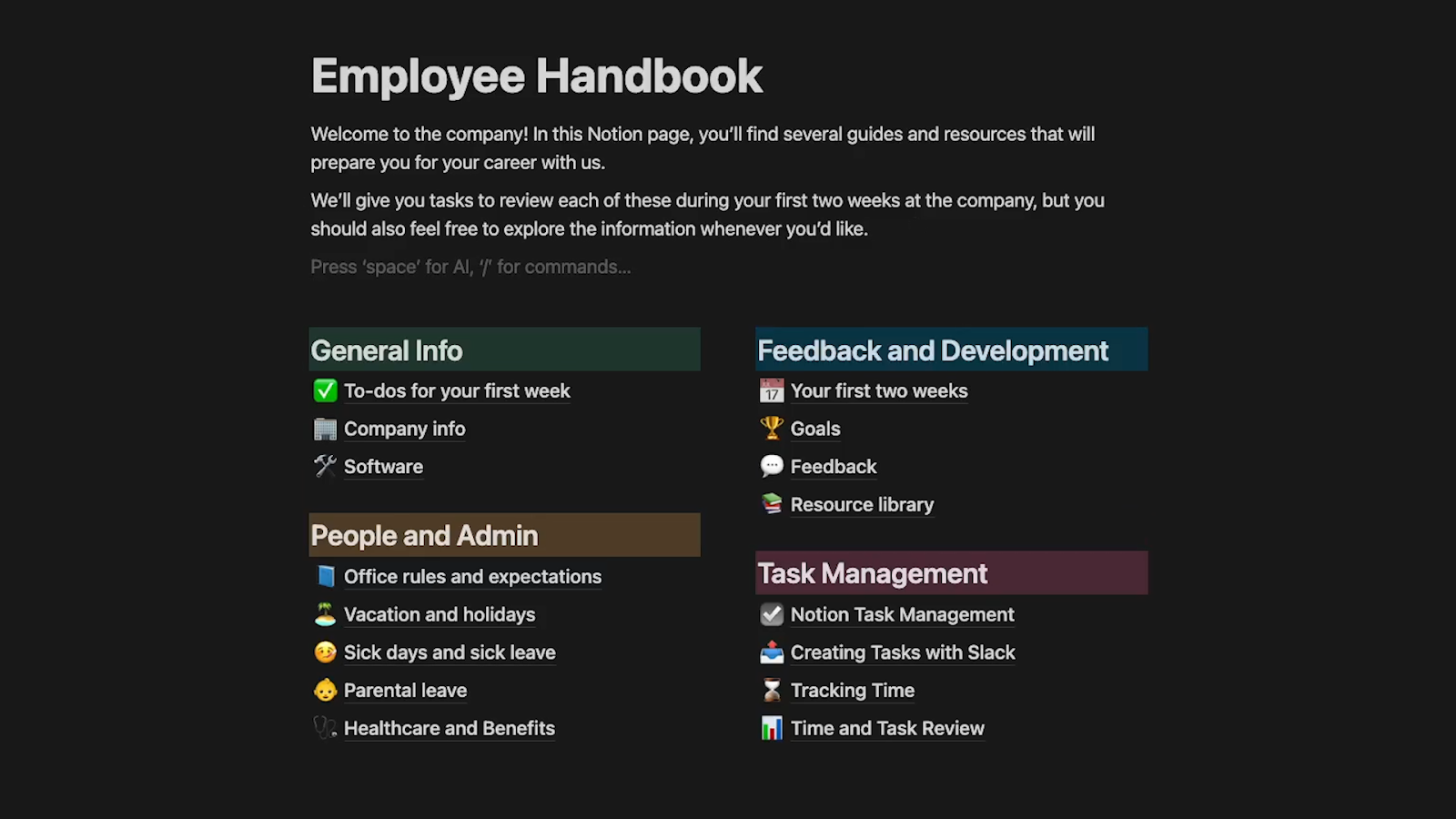
In essence, Notion is a highly versatile platform that lets you create and customize nearly any type of document that you can think of. You can then share and edit all of those docs with your team, making it a great tool for collaboration.
At its core, Notion is all about creating text documents and databases. But its greatest strength lies in its customization abilities.
With Notion’s wide variety of content blocks, and the ability to nest documents within other documents, you can create nearly any type of layout that you want for your workspace. You can nest databases in pages, nest pages in those databases, create multi-column layouts, hide and show information with dropdown toggles, filter and sort the data in your databases to create custom views, and more.

However you need to organize information, Notion can do it. It can handle project and task management, product documentation, content calendars or personal tasks like vacation planning or keeping a journal.
To start building your own personalized workspace, all you need to do is learn how to use content blocks.
Notion’s Pricing Plans
But first, of course, you’ll need to sign up for Notion.
The good news is most of Notion’s core features are totally free for individual users. Additionally, if you have an email address with a “.edu” domain, you may be able to qualify for a free pro account.
If you want to use Notion to support your whole organization, team plans start at $8 per user per month.
AI features are also available for an additional $10 per month.
You can see more details on their pricing page, which you can find along with other key resources in the Workflow Board we’ve compiled for this guide.
But a free account is all you need to follow along with our tutorial for creating pages and databases. Just go to Notion.so and make your account to get started.
Creating a Page and Adding Content Blocks
Once you’ve created an account and signed in, you’ll see a simple interface. On the left, you’ll see all of the pages you have access to. If you’ve just created your account, you’ll only see a set of example pages created by Notion. You’ll also see your Teamspaces on top of this panel, if you’re part of a team plan.

Everything in Notion is built around pages, and any data you create has to be stored within a page. So to start exploring Notion, just click on “Add a page” to create a new page.
You can type directly in the page to start creating your content. To bring up a menu where you can access different styles or special blocks, type /. Here, you’ll see a long list of text types and blocks.
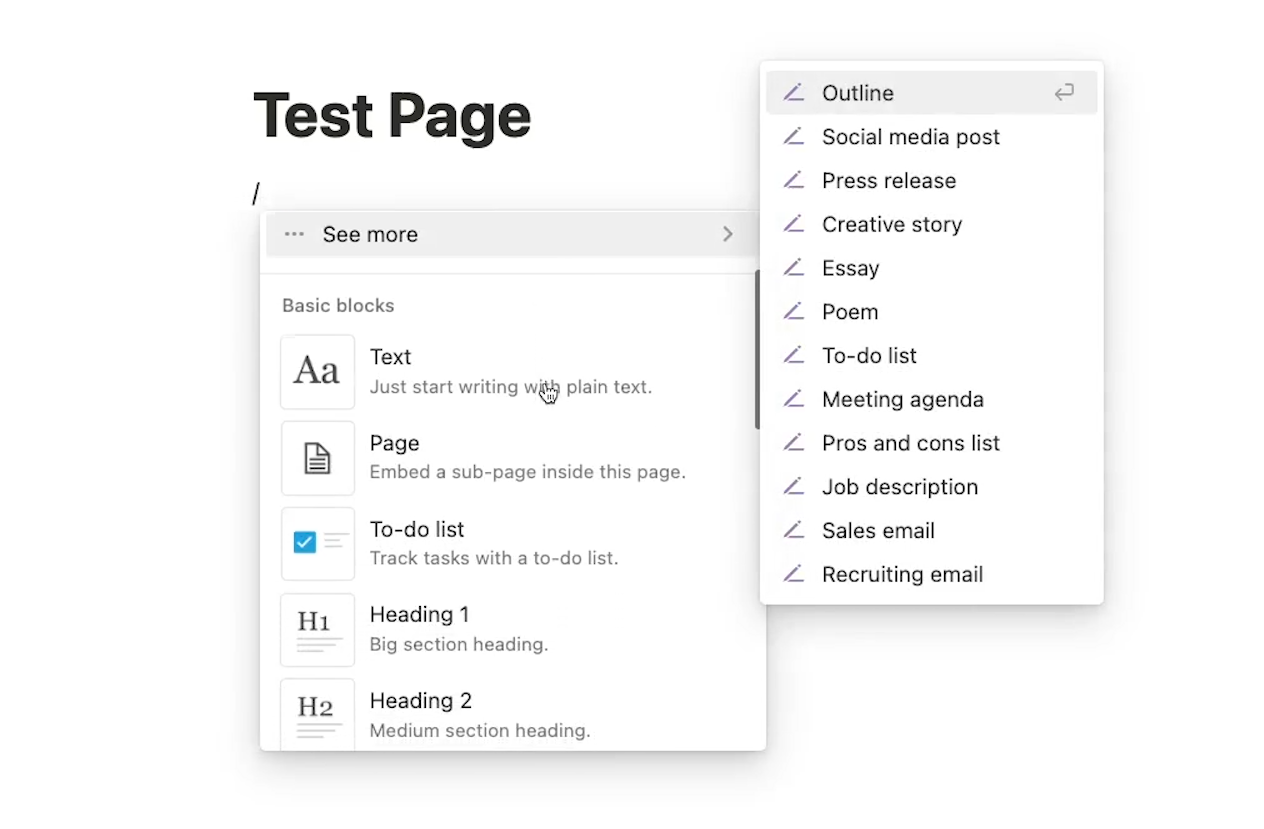
To quickly find what you’re looking for, just enter a search term right after the forward slash. We’ll search for “H1” to find a large heading that we can use as a title for this page.

After we’ve added our title, we’ll hit “enter” to start a new block. By default, every new block will just be a plain paragraph. If you want to change the type or style of any block, just hover over it, click the dots on the left, and select an option under “turn into…”
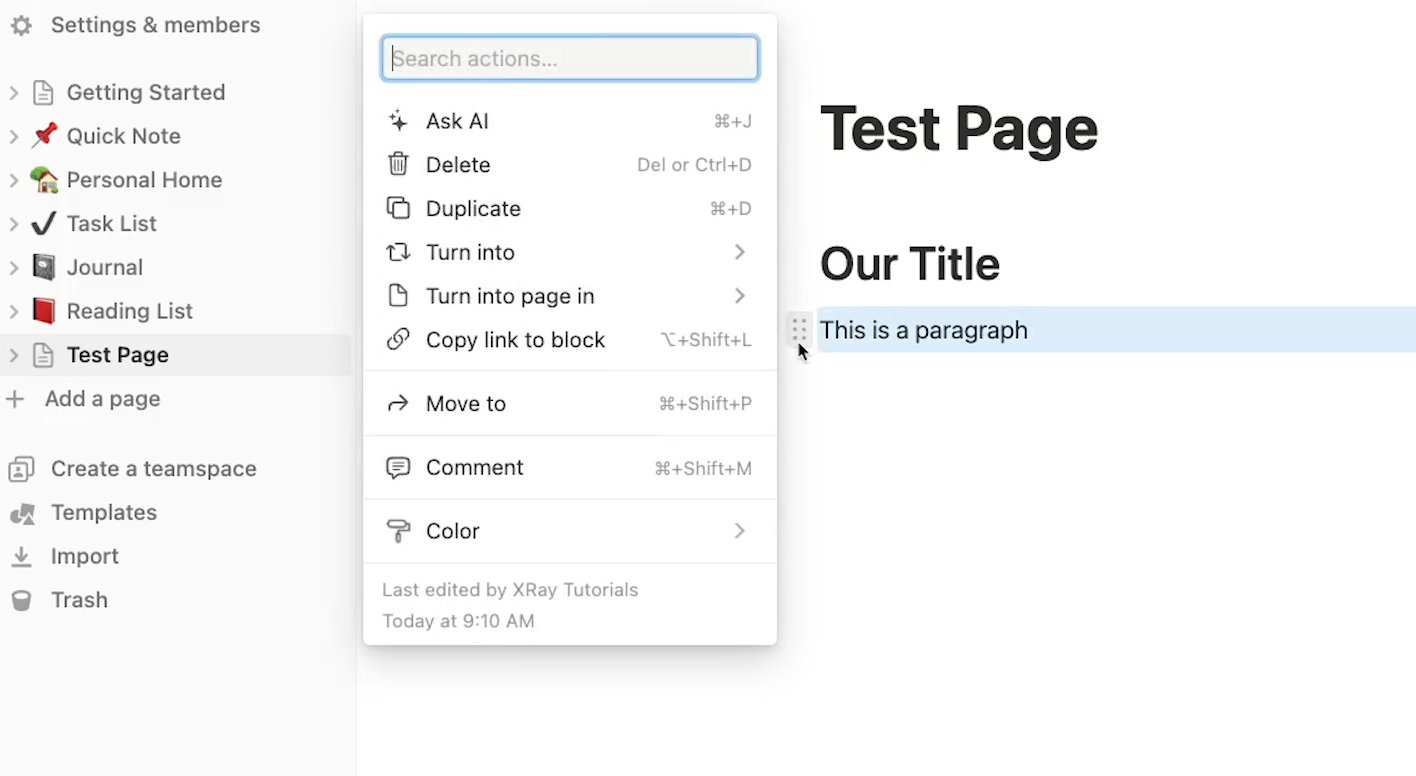
There are a ton of options for content blocks, so we won’t cover them all right now, but there are a couple we want to quickly highlight.
Bullets are convenient for jotting down some quick notes or making a list of instructions.
Toggle dropdowns are a great way to hide or show lengthy lists with a single click. If you need to add a FAQ to your workspace, toggle dropdowns are the best way to go.
Markdown Shortcuts for Content Blocks
Want to make blocks even faster? There are also a lot of markdown based shortcuts that you can use to bypass the block menu and instantly add the block you’d like with one or two keystrokes.
For example, you can use an asterisk * to start a bulleted list, or use two brackets [] to start a to-do list with checkboxes.
To quickly add a toggle, you can just use the “greater than” > symbol.
For a larger list of shortcuts, check out the Workflow Board for this guide.
Multi-column Layouts and Images in Notion
Notion also makes it easy to create a multi-column layout. Just search for “column” to see your options. Notion will automatically divide the block into a few columns.

Within each column, you still have access to all of Notion’s other block types. You can create headings, bulleted lists, toggles, and more here. To resize them, just click and drag on the edge.
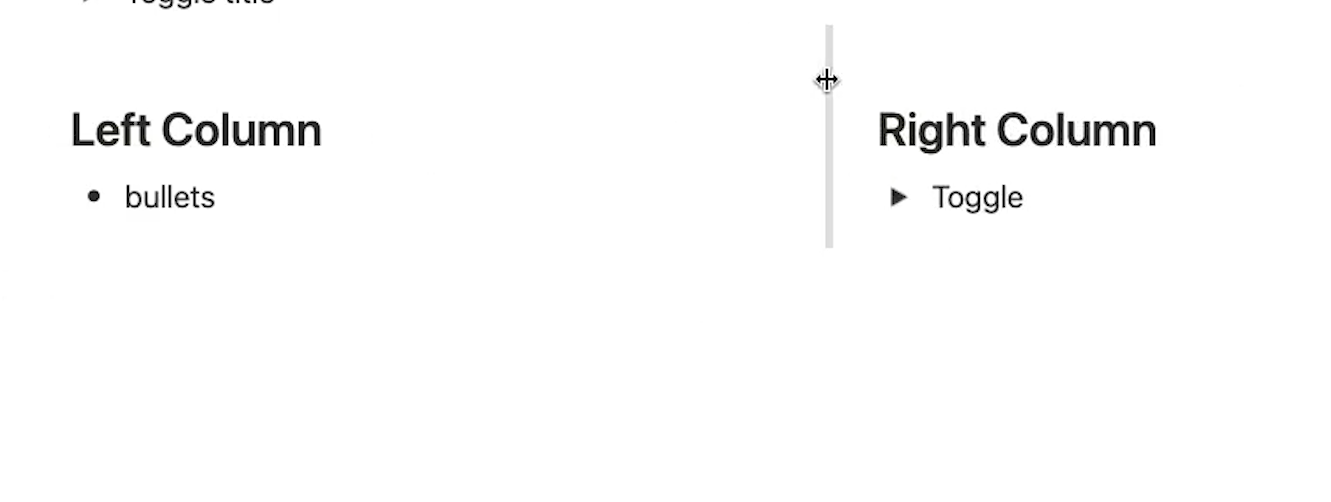
Next, you can add images to your page to give it a little visual appeal. Just search “image”, and select the appropriate block. Then, upload any image you’d like to use. Alternatively, you can just a drag and drop an image from your desktop into your Notion page.

Notion AI
To finish out our quick overview of Notion content blocks, let’s touch briefly on Notion AI.
Notion has recently added an AI assistant which you can use to generate or edit text with simple prompts.

Just type “/AI” to get started, or hit the spacebar. We’ve created a separate guide for Notion AI which you can check out here if you’d like to see more of what Notion AI can do.

Again, there are many more options for blocks, but they can all be accessed the same way by typing “/”, so we’d encourage you to explore those for yourself.
For now, let’s take a look at nesting pages within pages.
How to Nest Pages Within Pages in Notion
All of the blocks we’ve covered so far probably seem like nice features for a word processor, but they might not seem like anything too impressive just yet.
Here’s where things start to get a little more interesting: we can easily nest pages within other pages.
Just type “/page” to create a new page. This creates a page within our original page, and opens it up so we can add content there.

This sub-page has all the same features as our original page, so we can add any content blocks that we’d like here. We’ll also make sure to give it a title. Then, to get back to the parent page, we can just follow the breadcrumb menu in the top left.

Now, we can see that the parent page includes a link to the subpage we created.

Nested pages are a great way to organize your lengthy text documents and company wikis. For instance, you might be creating an employee handbook, or some technical product documentation. With nested pages, you can separate your content into pages for each employee role, or pages for each use case for your app.
This will make your documents much easier to navigate than a 50-page long Google doc, but much more contextually organized than a huge list of docs in a folder.
If you need to find any of your pages, just hit Command + K on Mac or Ctrl + K on windows to search through all of your pages, their titles, attributes, and blocks.

Creating and Linking Databases in Notion
Notion’s not limited to only creating text docs. One especially useful block type that it offers is the database.
You can create a database by typing “/database”.
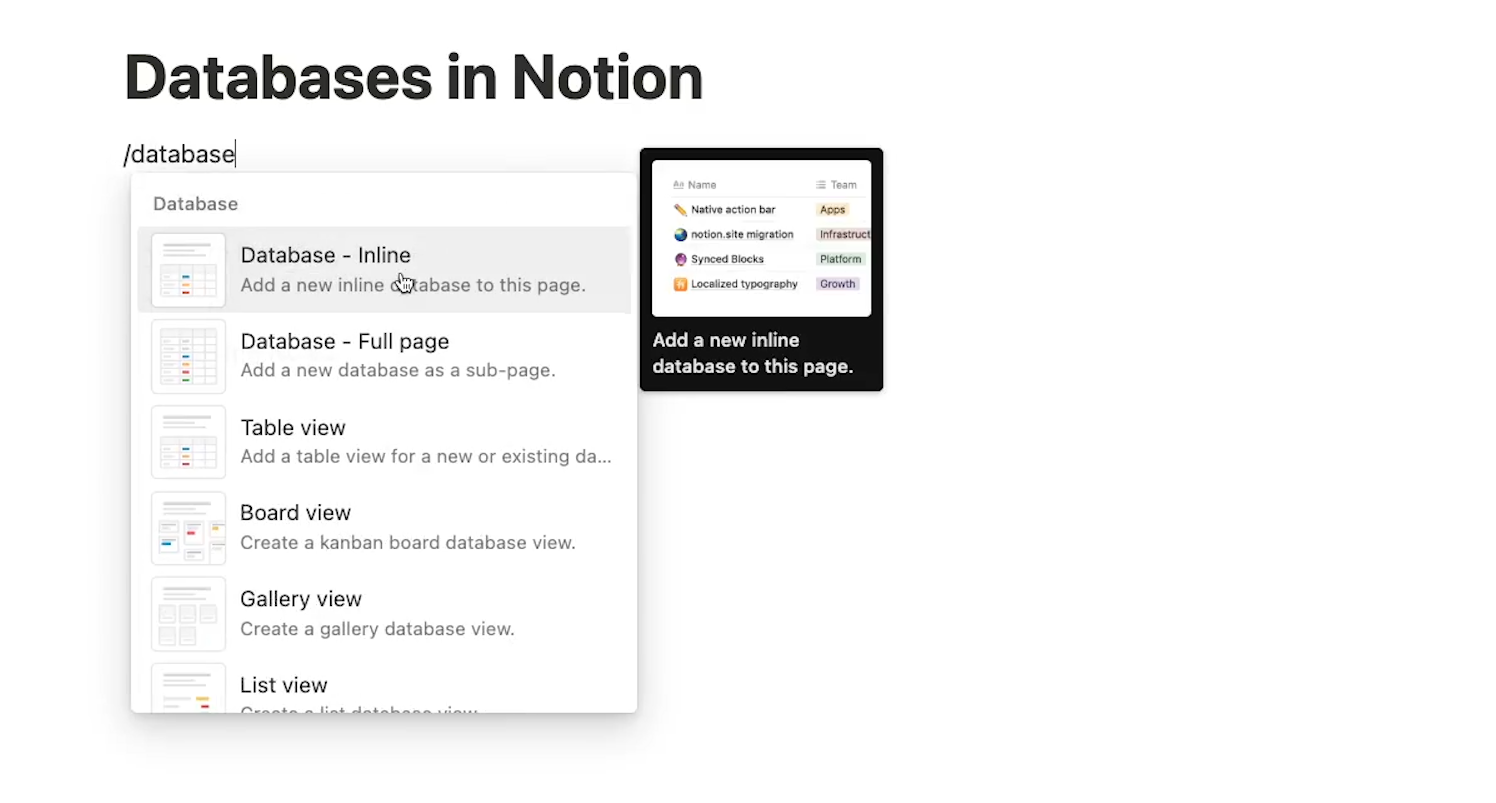
This will add a fully functional database for storing and sorting data to your page.
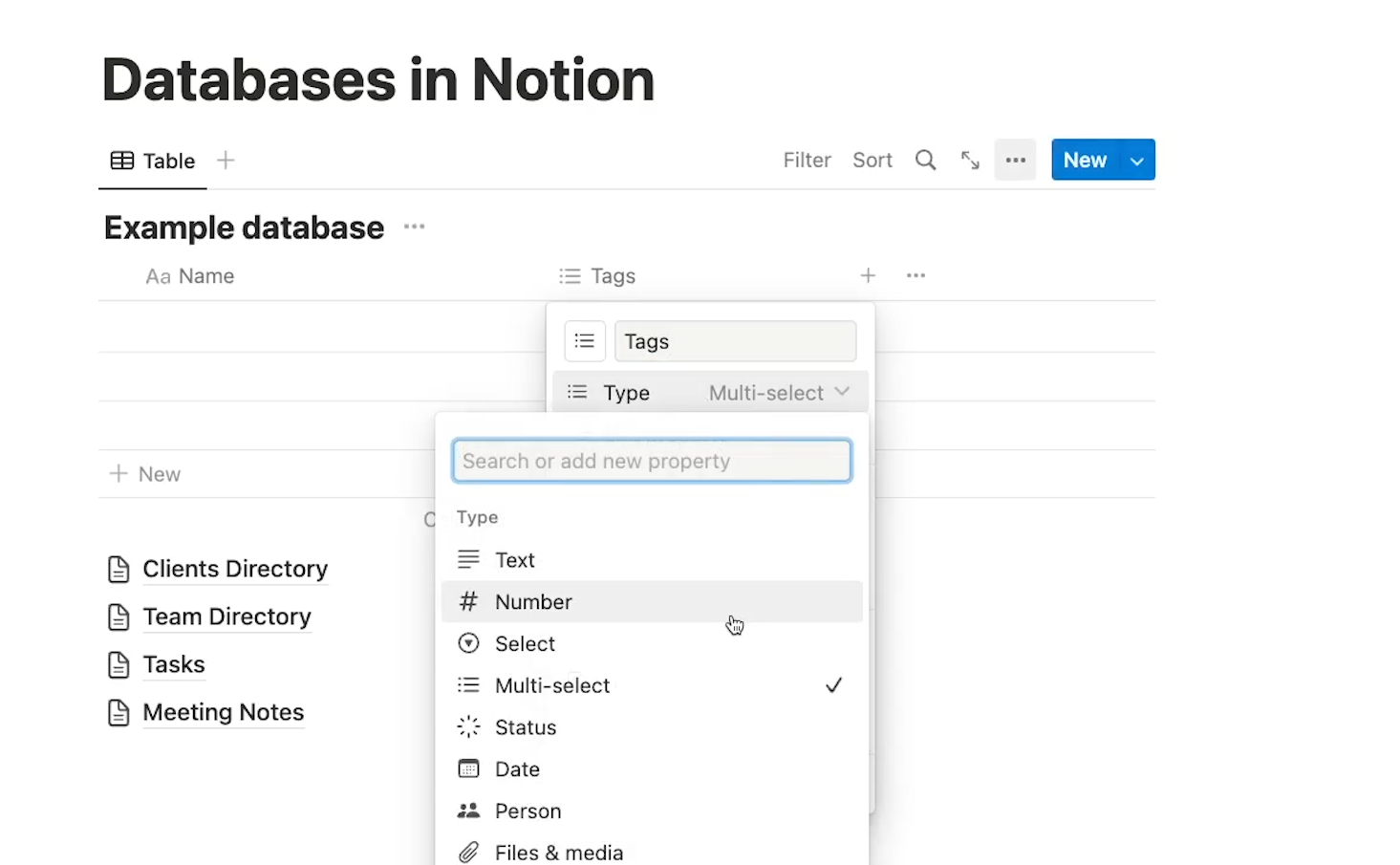
This database is more than just a grid to arrange your text. Databases in Notion include several different field types, like date, single select and multi-select, checkboxes, and more.
Linking Notion Databases with “Relations”
You can even use the “Relation” field type to create links between two different databases. A relation associates a record in one database with a record in another database
For example, you might want to link each project manager in your team’s directory with a client in your Clients database.
To create the relation, start by adding a new property and selecting the “relation” type.
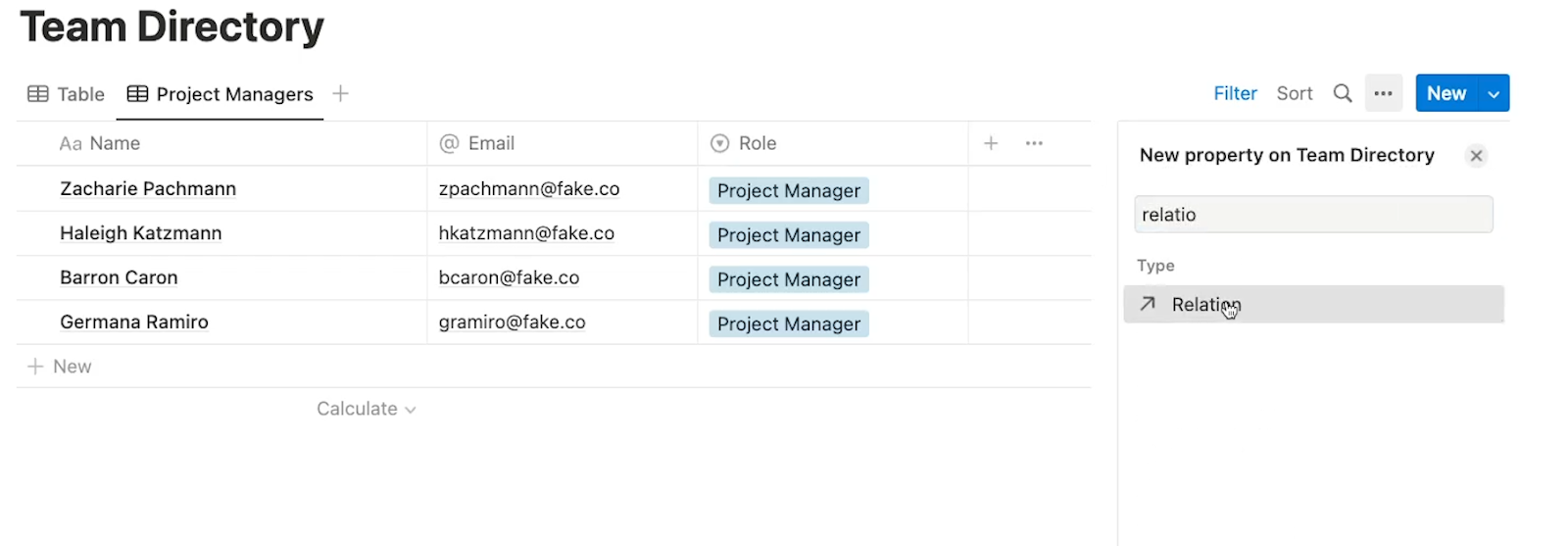
Then, pick the other database that you want to create a relation to.

Choose whether or not you want to show the relation in both tables, then add the relation.
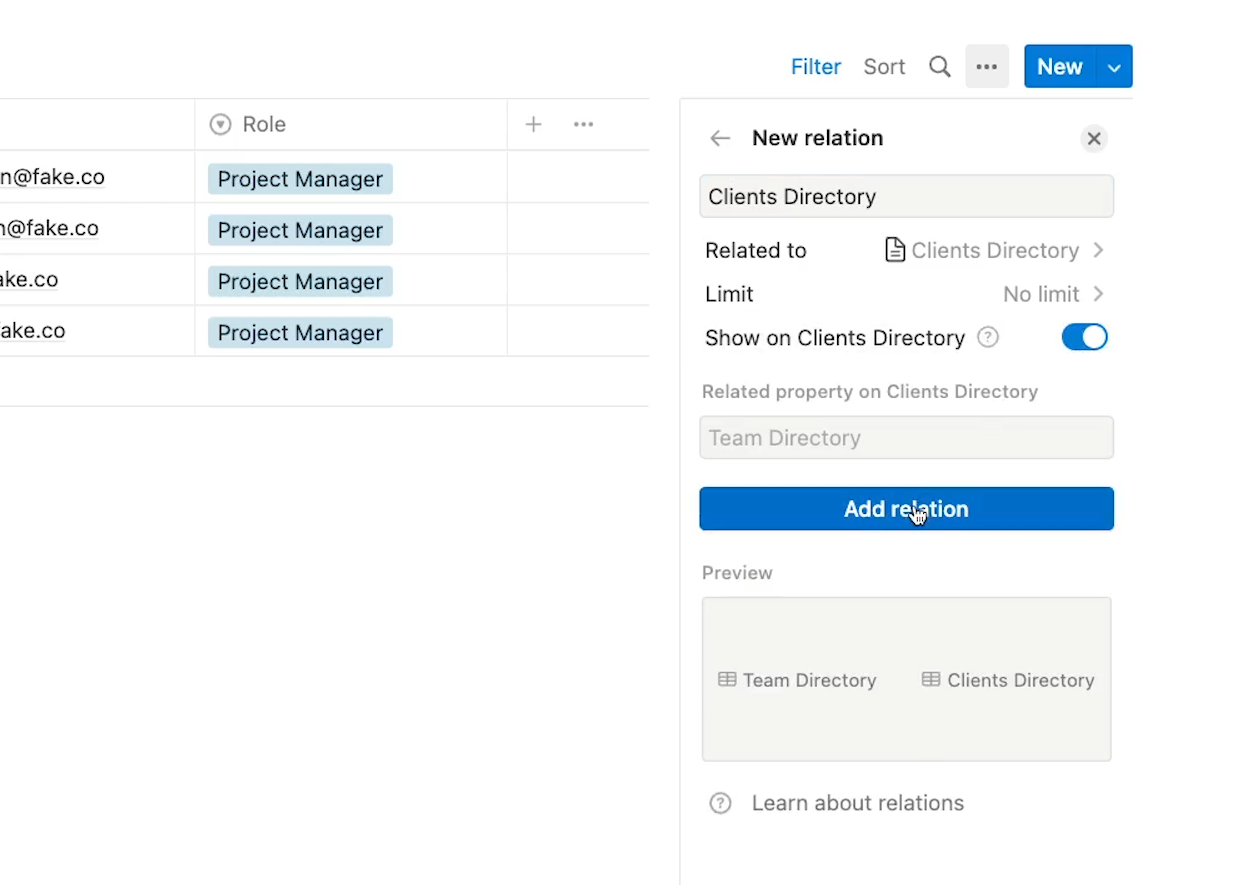
Now, you’ll be able to fill in the “relation” field with a link to a record in the related database.
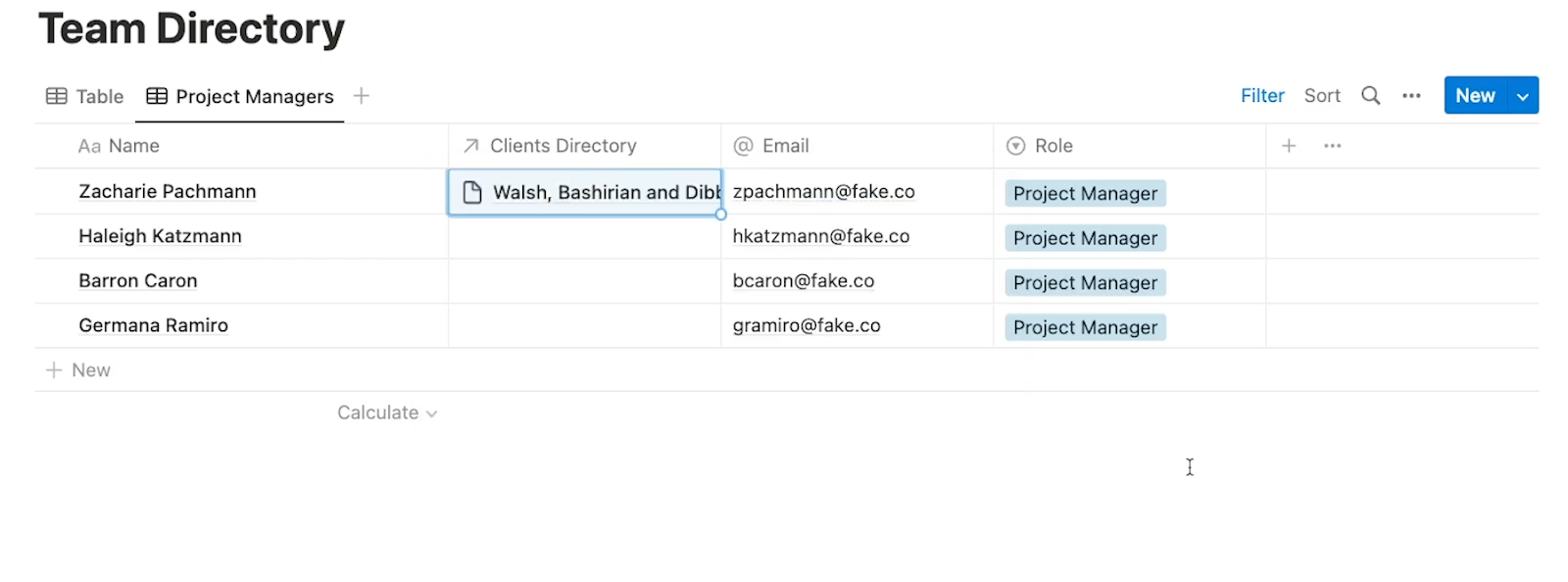
Then, you can also add rollup fields to display fields from the related record. For instance, you could include the client’s main point of contact, the project due date, project type, etc.

Whenever you update the data in the “Clients” database, any related records and their rollups will be updated automatically as well.
With relations, you can display the same data in multiple spots without messy copy and pasting, or needing to update separate databases every time you need to make a change.
Using Filters in Notion Databases
With filters, you can also display and hide data based on customized conditions. Then you can save that filter to a unique View, so you can quickly find data you need.
For instance, we’ll add a filter to this database of tasks so that we’ll only see tasks that aren’t marked as “Complete” or “Archived”.
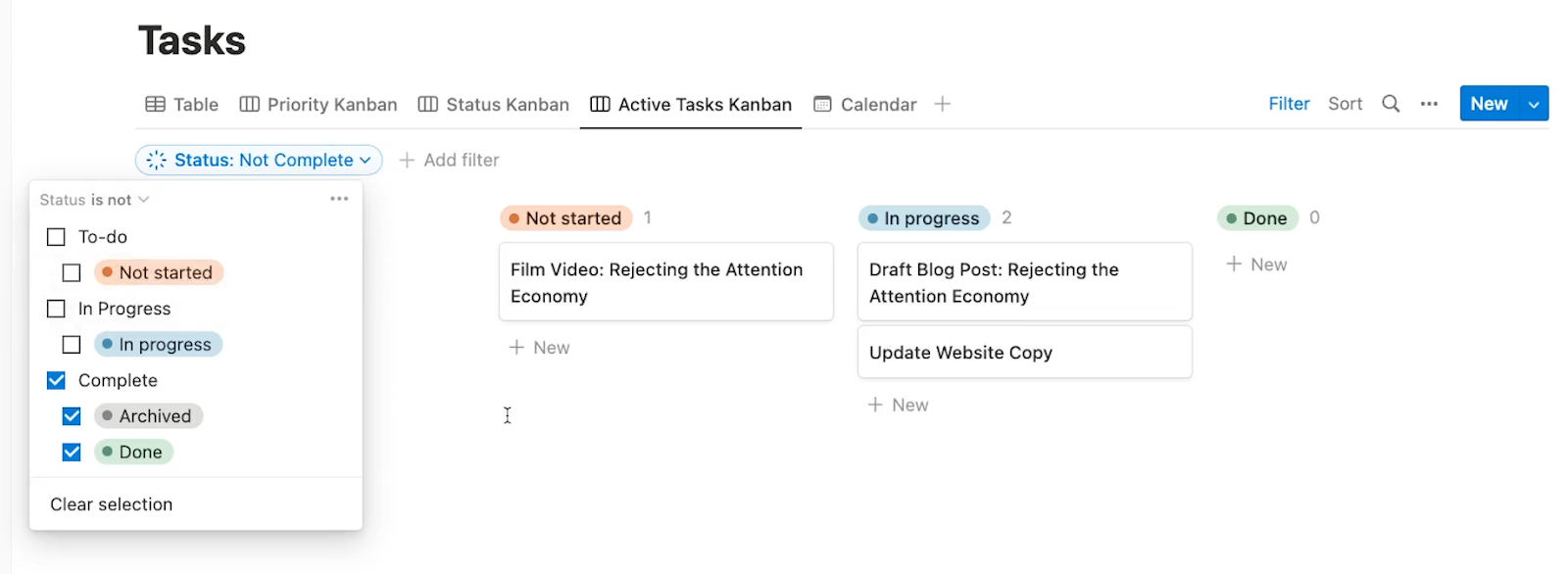
In addition to filters, different views can also include completely different ways to arrange your data.
For instance, you might want to use a kanban view to sort your tasks by status or triage them by priority.

Or you could use a calendar view to keep track of your planned blogs and social media posts.

Just click on the “+” to add a new view, and choose the type you’d like to use.
Creating Pages Inside of Databases
The last database feature we’ll cover in this guide is the ability to create pages within your databases.
Each record in a database can be opened as a page.

Then, you can add all of the same text, content, and blocks that you have access to in any page.
This can be a great way to add notes to any database record, or to organize a long list of similar documents.
For instance, if you’re creating a new “meeting notes” doc every day, it may make more sense to structure them as a part of a database rather than creating a new “Page” in Notion for each entry.

Use Caution with Notion Databases and Nesting Pages
However, there are a couple areas where you should be cautious with Notion databases.
If you try to share a page with a client or someone who is not part of your workspace, any relational fields that you’ve added will show up as blank.
That’s because your client, who will likely be added as a “view-only” user, won’t have access to the other database referenced by the relation.
Additionally, if you nest pages inside of pages inside of a database, there's really no good way of knowing how deep those nested pages go within that database. You can’t filter for nested pages, or use any other method to know how many levels deep it goes, except for clicking on each subpage manually.
Be careful about nesting too many pages within pages within pages. It might make things difficult for your coworkers.
These really aren’t deal breakers with Notion; just a couple of words of caution for prospective power users!
Create Your Ideal Layout with Custom Blocks or Templates
Ultimately, with all of the options at your fingertips for customized pages and databases, Notion gives you the ability to create nearly any workspace you can imagine.
With Notion, you can make your project management system, a content calendar, a journal, or whatever else you’d like.
But if you’re not sure where to get started, you can always try templates. Templates let you copy a premade Notion layout with a single click. You can check out our blog about Notion templates for some recommendations, or browse the Notion template gallery to get started.
Where does Notion fit into a Software Stack?
So where does Notion fit in your software stack? Notion’s a very versatile app, so you can configure it to fit a lot of different use cases.
But it primarily excels at building workspaces to manage your projects and tasks, and at creating any text documents that you or your company need to reference on a regular basis. As such, Notion can fully replace apps like Clickup, or Monday.
It also replaces many common use cases for apps like Google Docs and Microsoft Word, but there are still areas where those programs will be more appropriate for the context. Drafting copy, particularly for any long-form content, is often going to be easier in Google Docs.
Additionally, formal documents that require fine-tuned formatting like contracts, proposals, or essays may be better suited to apps like Word. \
Basically, if you need pagination and footnotes, you’ll need to use a different app. And in those situations, you really won’t need Notion’s visual styling options.
Sharing material with people outside of your organization is also far simpler in apps like Google Docs. You just share the necessary doc or folder, and you don’t need to worry about issues with referenced tables or nested pages preventing your collaborator from seeing your content.
However, if you need to quickly make a visually engaging doc, or a resource that your organization needs to access a lot, Notion will often be the preferable choice. Its search function also works much better than Google docs, as it lets you search the content of every block instead of just reading titles.
Alternatives to Notion
If you’re looking for an alternative to Notion, you may want to look at Coda, Airtable, or Roam Research. Coda is very similar to Notion on the surface, but its structure is based more on databases than pages. Airtable also employs a database-focused approach, while Roam is generally similar to Notion as a document-focused app.
Set Up a Custom Workspace for Your Team or For Yourself
Notion is a great tool for organizing docs and data for your company, or for yourself. Once you get familiar with creating pages and databases, there’s no limit to what you can build. And if you want to get started faster, just copy a template for inspiration.
If you’d like to learn more about Notion and other no-code tools, check out our blog or our YouTube channel. You can also follow XRay on Twitter, Facebook, or LinkedIn.





